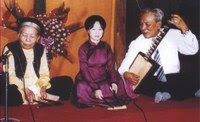
Ca Tru - an impromptu performance art which has a somewhat academic character - has been around for a thousand years. If one appreciates Ca Tru one almost certainly appreciates poetry and music. Ca Tru is also known as Hat Nha Tro (singing or dancing with humor), Hat Thuong (singing for king or mandarins), Hat Cua Quyen (singing in royal palaces), Hat Cua Dinh (singing for religious rituals) and Hat A Dao (the name of a famous songstress during the Ly dynasty). During the time of French administration, Ca Tru went into decline. Nowadays, it is being revived and promoted as a popular art form.
When did Ca Tru first appear?
One can find dan day (a musical instrument that accompanies Ca Tru singing) carved in stone in 16th century temples and pagodas in northern Vietnam: the Lo Hanh Temple in Hiep Hoa, Bac Giang, the Hoang Xa Temple in Ung Hoa, Ha Tay and the Tam Lang Temple in Can Loc, Ha Tinh. The earliest known written mention of Ca Tru is in Dr. Le Duc Mao's (1462-1529) book 'Le toc gia pha' (written prior to 1505) in the chapter 'Dai nghi bat giap thuong dao giai van'. Ca Tru is song that combines literature and music and it was popular for centuries in Vietnam's ancient capital city of Thang Long. From there, Ca Tru spread to other parts of the country. Ca Tru was a Vietnamese cultural practice and spiritual food for people in both royal palaces and the countryside. Ca Tru is a distinctive form of performance art that has both academic and popular character.
Musical instruments in Ca Tru: The co phach, dan day and trong chau.
Co phach: The instrument can be divided into three segments. The ban phach part is made of bamboo or wood. A singer uses two wooden sticks called phach cai or phach con to strike the bamboo or wooden piece to create a sound called phach. The phach sound keeps time for the singer and is in fact 'another voice'.
Dan day: This musical instrument is used only for Ca Tru singing. It has a rectangle or trapezoid-shaped body. The face is of a better kind of wood and the long neck has 10-11 frets. It has three strings that are made of silk and a dan day player is called a kep. The sound of the dan day, deep and profound, combines with the clear and sharp phach sound to create a musical contrast that is unique. The dan day is plucked with a piece of plastic or bamboo.
Trong chau: The trong chau that's used with Ca Tru is different in size and shape from the drum used in Tuong singing (a kind of Vietnamese classical drama), and it's beaten differently. It is the same drum that's used with Cheo singing but with Ca Tru it's beaten in an entirely different manner. The drumstick is made of wood and is longer than most others and the drummer expresses himself when beating the drum, encouraging the singer.
These three instruments, the dan day, the co phach and the trong chau, are inseparable. A subordinate instrument, the drum serves as a bridge between the performer and audience. The harmony that comes from the combination of the dan day, the co phach and the human voice makes the performance unique.
Generally, Ca Tru as a high art form is unique to Vietnam and is a valuable part of Vietnam's musical legacy and culture.

No comments:
Post a Comment